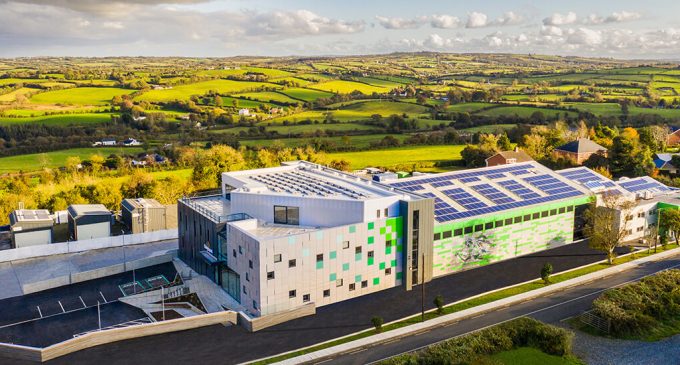This Smart Building Is a Living Lab for a Greener Future in Construction – Kingspan

There was a time when the annual World’s Fair was the planet’s primary showcase for “the buildings of tomorrow.” People from around the globe gathered in futuristic national pavilions to gape in awe at what the future of construction might bring.
Today, concern for the environment balances that enthusiasm for progress. Where they once aimed for Space Needles and flying-saucer-like observation towers, construction industry leaders now focus on innovations that make buildings greener and more responsive to the needs of occupants—thinking smaller, you might say, in order to see the bigger picture.
Industry research by Kingspan, a global leader in high-performance insulation and building envelopes, confirms the need for this evolution in thinking. It shows that the construction and operation of buildings account for 36% of global energy use. It also shows that construction accounts for 39% of energy-related CO2 emissions (when upstream power generation is included) and approximately 30% of the waste sent to global landfills.
An Environment for the Mind
This research informed the design and construction of IKON, Kingspan’s global innovation center. Opened in 2019 amid the lakes and rivers of County Cavan, north of Dublin, IKON represents an investment of 10 million euros in Kingspan’s commitment to a greener future. It functions as a “living experiment,” providing engineers with the perfect real-world setting to measure the energy-saving properties of new materials.
“The original idea for IKON was to combine research into advanced materials with digital technology,” says Mike Stenson, Kingspan’s head of innovation. “In doing that, we realized we could create a building that was both digital and sustainable from the ground up.
“There are multiple sensors throughout IKON that enable us to measure energy consumption,” he continues. “We also utilize natural lighting, rainwater, solar panels, and other elements to create a workspace built on sustainable practices.”

Kingspan Head of Innovation Mike Stenson. Courtesy of Kingspan
Sustainable Ambitions
This focus on sustainability feeds into Kingspan’s 10-year mission to increase its direct use of renewable energy to 60%. In fact, the company aims to achieve net zero carbon manufacturing by 2030.
“Construction is a carbon-intensive industry,” adds Bianca Wong, head of global sustainability at Kingspan. “As manufacturers, we all have a responsibility to address the issue. The learnings from IKON will help us maintain and achieve our net-zero commitments. As a result, they’ll support our customers in delivering net zero in their buildings.”
IKON itself was built using recycled (and recyclable) materials. A lot of work was also done on the energy modeling of the building during the design stage. “For instance, solar panels on the roof generate enough power to meet 35% of the building’s energy demand,” Stenson says. “The car park contains charging points for electric cars. There’s even a rainwater recovery system for use in toilets and sanitation.”
Made from recycled plastic bottles, the building’s insulation follows in this path. The company now plans to recycle between 300 and 400 million plastic bottles each year.
Digital Inspiration
The center is also home to Kingspan’s Digital Team. This team leads research into how the company can bring more intelligence into its products, prepare for Industry 4.0, and align with the “model first” approach to creating new buildings.
For the team, IKON provides the perfect setting to ask some of construction’s big questions: What role will augmented reality, virtual reality, and the Internet of Things (IoT) play in building management? How will artificial intelligence and Big Data transform architectural design?
Through technology partnerships and its own findings, Kingspan aims to make IKON the world’s first level-5 maturity digital twin. Leveraging technologies such as Autodesk Forge, Kingspan uses IoT devices and video cameras to visualize building performance in the context of IKON’s rich 3D BIM (Building Information Modeling) data, creating an “occupancy-aware” building.
Data-Driven Construction
“For instance, we can anonymously gather data pegged to people, behavioral patterns, and time of day,” says Brian Glancy, Kingspan’s head of BIM strategy. “Through this, we’re better able to live up to the idea of performance products for performance environments. Catering our buildings to the behavior of their occupants is already translating into things like improved insulation performance to gain more space.”
Glancy says better command of building data also means systems such as HVAC and sanitation can be more responsive to human activity. To achieve this, a computer-vision system from Autodesk is deployed at IKON. Designed from the ground up with anonymity in mind, the system directly addresses data-usage concerns in similar solutions. Although the system is still in research and development, Kingspan’s team has used it to accurately detect anonymized occupant movement, represented as skeleton visualizations, for behavioral analysis.
By turning human activity into data and analyzing it against metrics such as energy consumption by room or floor, or how people socially occupy a space, Kingspan hopes to help the construction industry create better occupant-simulation models. These could inform the creation of more energy-efficient buildings optimized for comfort, wellness, and productivity.
Buildings That Learn
Kingspan’s Stenson believes that IKON’s novel use of data, reliance on green materials, and living laboratory structure will continue to drive company and industry innovations for years to come.
The team’s research shows that one day, buildings could take advantage of machine-learning algorithms to respond to behavioral and environmental data proactively. Modern, interconnected building subsystems could maintain comfort as well as productivity for occupants, while minimizing energy use.
IKON’s use of data may also advance construction’s contribution to the circular economy. With access to hyper-detailed building data, companies dismantling or refurbishing properties will know exactly which materials and components have been used and where they’ve been installed. This information makes material recovery easier, turning demolition sites into resources rather than sources of waste.
“IKON allows us to try out building and design software in a live setting, explore new directions in areas like solar, and improve access control—all done with data,” Stenson says. “I think we’ve only scratched the surface.”
Reference: https://www.autodesk.com/redshift/smart-building/




























